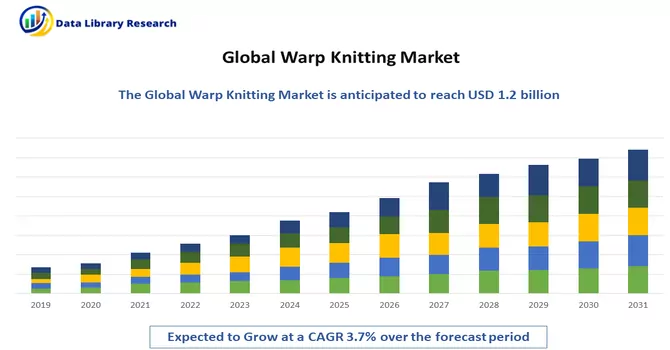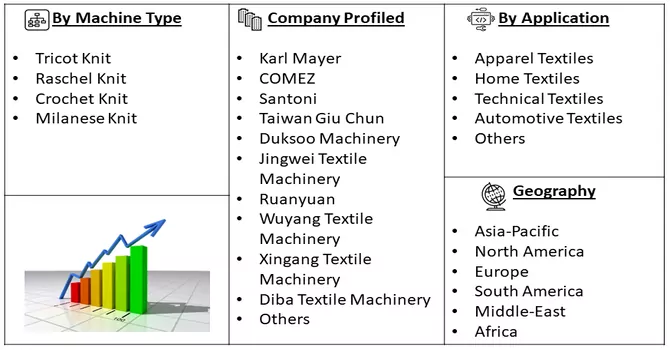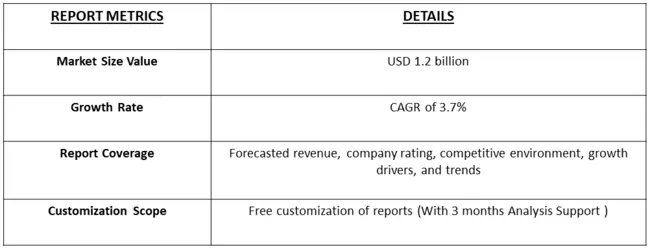The Global Warp Knitting Machine Market is currently valued at 1.2 billion and is expected to grow at a CAGR of 3.7% over the forecast period of 2024-2031.

Get Complete Analysis Of The Report - Download Free Sample PDF
The Global Warp Knitting Machine Market is a dynamic and integral segment of the textile machinery industry, playing a crucial role in the production of various textile products. Warp knitting machines are recognized for their efficiency in producing fabrics with diverse patterns, structures, and textures. The market is driven by the increasing demand for warp-knitted fabrics across industries such as apparel, automotive, sports, and technical textiles. Factors like rapid industrialization, advancements in technology, and the rising preference for warp-knitted fabrics contribute to the market's growth. Additionally, the versatility of warp knitting machines in creating intricate designs and the efficiency in handling different yarn types further fuel their adoption.
As the textile industry continues to evolve, the Global Warp Knitting Machine market is anticipated to witness sustained growth, driven by innovation, automation, and the demand for high-quality, customized textile products across various applications. A primary growth-driving factor for the Global Warp Knitting Machine market is the increasing demand for advanced and diverse textile products across various industries. The versatility of warp-knitted fabrics in terms of patterns, structures, and textures makes them highly sought after in applications such as apparel, automotive textiles, sports gear, and technical textiles. The textile industry's constant evolution and the rising preference for innovative, high-quality fabrics contribute to the growing adoption of warp knitting machines. Additionally, advancements in technology and machinery automation enhance the efficiency and capabilities of warp knitting machines, catering to the evolving needs of manufacturers. As industries continue to seek customized and intricate textile solutions, the Global Warp Knitting Machine market is poised for sustained growth, driven by its pivotal role in meeting the dynamic demands of the global textile landscape.
Market Segmentation: The Global Warp Knitting Machine Market is segmented by Machine Type (Tricot Knit, Raschel Knit, Crochet Knit, Milanese Knit), Application (Apparel Textiles, Home Textiles, Technical Textiles, Automotive Textiles, Others) and by Geography (North America, Asia-, Europe, Middle East & Africa and South America). The report offers market size and forecasts for the Global Warp Knitting Machine Market in value (USD billion) for all the above segments.

For Detailed Market Segmentation - Download Free Sample PDF
Market trends in the Global Warp Knitting Machine market reflect a shift towards technological advancements and innovation, driven by the growing emphasis on efficiency and sustainability. One prominent trend is the integration of smart technologies and automation in warp knitting machines, enhancing precision and reducing production time. Manufacturers are increasingly focusing on developing machines that can accommodate a wide range of yarn types and offer flexibility in creating intricate designs. Additionally, there is a noticeable trend towards the adoption of environmentally friendly practices in the production of warp-knitted fabrics, aligning with global sustainability goals. The market is witnessing a surge in demand for warp knitting machines capable of producing high-performance technical textiles for applications like geotextiles and medical textiles. As the industry continues to evolve, the Global Warp Knitting Machine market trends indicate a convergence of cutting-edge technology, sustainability, and versatility to meet the evolving demands of the textile sector.
Market Drivers:
Technological innovation
Technological innovation stands at the forefront of societal progress, revolutionizing industries and shaping the way we live and work. In today's dynamic landscape, rapid advancements in areas such as artificial intelligence, machine learning, and biotechnology are driving unprecedented changes. This innovation extends across diverse sectors, from healthcare and manufacturing to communication and transportation. The integration of smart technologies, automation, and data-driven solutions is enhancing efficiency, productivity, and overall convenience. As businesses and individuals embrace cutting-edge tools and solutions, technological innovation becomes a catalyst for economic growth, sustainability, and improved quality of life. The ongoing pursuit of new ideas, discoveries, and creative problem-solving continues to propel the world into an era defined by the transformative power of technology.
The increasing demand for versatile textile solutions
The increasing demand for versatile textile solutions underscores a dynamic shift in consumer preferences and industrial requirements. Industries such as fashion, automotive, sports, and technical textiles are witnessing a growing need for fabrics that offer a combination of functionality, aesthetics, and adaptability. Consumers seek diverse and customized textile products, driving manufacturers to invest in technologies and machinery that can produce a wide range of patterns, structures, and textures. This demand for versatility is particularly evident in applications like apparel with varying fashion trends and technical textiles requiring specialized performance attributes. As a result, the textile industry is evolving to meet these multifaceted demands, emphasizing the importance of flexibility and adaptability in the production of innovative and tailored textile solutions.
Market Restraints:
Market restraints for the Global Warp Knitting Machine market include factors such as high initial capital investment, which can pose a challenge for smaller players and new entrants looking to adopt advanced technology. The complexity of operating and maintaining sophisticated warp knitting machines may also act as a barrier, requiring skilled personnel and specialized training. Additionally, the market may face constraints related to fluctuations in raw material prices, affecting the overall cost of production for warp-knitted fabrics. Economic uncertainties and global events can impact consumer spending patterns, influencing the demand for textiles and subsequently affecting the market. Moreover, the environmental concerns associated with textile manufacturing may lead to stricter regulations, adding compliance challenges for warp knitting machine manufacturers. As the industry navigates through these challenges, strategic solutions and innovations will be essential to overcome restraints and foster sustained growth in the Global Warp Knitting Machine market.
The COVID-19 pandemic has significantly impacted the Global Warp Knitting Machine market, causing disruptions across the textile industry. The widespread lockdowns, supply chain interruptions, and restrictions on manufacturing operations led to a slowdown in production activities. The decline in consumer spending, particularly in the apparel sector, resulted in reduced demand for textile products, affecting the utilization of warp knitting machines. Supply chain complexities, including delays in the delivery of raw materials and components, further impeded the seamless functioning of the market. The economic uncertainties and market fluctuations induced by the pandemic prompted manufacturers to reassess their strategies, emphasizing resilience and adaptability. As the industry gradually recovers, the lessons learned from the COVID-19 impact underscore the importance of agile and responsive approaches to navigate unforeseen challenges in the Global Warp Knitting Machine market.
Segment Analysis:
Apparel Textiles Segment is Expected to Witness Significant Growth Over the Forecast Period
The Apparel Textiles and Wrap Knitting Machine Market are integral components of the global textile industry, demonstrating significant growth and innovation. As the demand for diverse and sustainable textiles rises, these markets play a crucial role in meeting the evolving needs of the fashion and apparel sectors. The Apparel Textiles Market encompasses a wide range of fabrics, from casual wear to high-end fashion, with a focus on comfort, durability, and aesthetics. In parallel, the Wrap Knitting Machine Market contributes to this ecosystem by providing advanced machinery for the seamless production of knitted fabrics. Technological advancements in wrap knitting machines have led to increased efficiency, reduced production time, and enhanced fabric quality, meeting the intricate design requirements of modern apparel. The market is also witnessing a surge in demand for sustainable and eco-friendly textiles, driving innovation in both the materials used in apparel textiles and the knitting machines themselves. As sustainability becomes a focal point in the fashion industry, the Apparel Textiles and Wrap Knitting Machine Market is poised for continued growth and adaptation to the ever-changing landscape of consumer preferences and industry standards. The intersection of these markets is emblematic of the dynamic and responsive nature of the textile industry, reflecting a commitment to meeting the demands of a rapidly evolving global fashion market.
Home Textile Segment is Expected to Witness Significant Growth Over the Forecast Period
The Home Textiles and Warp Knitting Machine Market are integral components of the textile industry, contributing to the diverse and ever-evolving landscape of home furnishings. The Home Textiles Market encompasses a wide array of products, including bedding, curtains, towels, and upholstery, tailored to enhance comfort, aesthetics, and functionality within living spaces. This market is witnessing a notable shift towards sustainable and environmentally friendly materials, driven by consumer preferences for eco-conscious home products. Complementing the Home Textiles sector, the Warp Knitting Machine Market plays a pivotal role in the efficient and precise production of knitted fabrics used in these home products. These machines are characterized by their versatility and ability to create intricate and high-quality textiles, meeting the diverse design requirements of modern home furnishings. Technological advancements in warp knitting machines have led to increased automation, faster production cycles, and customization capabilities, further catering to the dynamic demands of the Home Textiles Market. As consumers increasingly seek personalized and sustainable home solutions, the synergy between Home Textiles and Warp Knitting Machine markets underscores the pivotal role they play in shaping the aesthetics and functionality of contemporary living spaces while embracing advancements in technology and sustainability practices. This dynamic interplay is indicative of an industry committed to meeting the evolving needs of consumers in the home decor and textile market.
North America Region is Expected to Witness Significant Growth Over the Forecast Period
The North American Warp Knitting Machine Market is a pivotal sector within the textile industry, reflecting the region's prominence in technological innovation and the production of high-quality textiles. As part of the broader textile machinery market, North America plays a significant role in driving advancements in warp knitting technology, which is crucial for producing a diverse range of fabrics used in various applications. In recent years, the North American Warp Knitting Machine Market has witnessed a surge in demand driven by factors such as increasing automation, customization requirements, and a growing focus on sustainability. Manufacturers in the region are investing in research and development to enhance the efficiency and capabilities of warp knitting machines, addressing the evolving needs of industries ranging from apparel and home textiles to automotive and industrial applications. The region's textile industry is characterized by a commitment to innovation, with a focus on producing high-performance fabrics. North American warp knitting machines are recognized for their precision, speed, and versatility, allowing manufacturers to meet the intricate design specifications of modern textiles. The market's response to the demand for sustainable and eco-friendly textiles has further spurred advancements in warp knitting technology, aligning with the region's emphasis on environmentally conscious manufacturing practices. Thus, the North American Warp Knitting Machine Market not only contributes significantly to the regional textile industry but also reflects the region's leadership in technological innovation, ensuring its continued role as a key player in the global textile machinery landscape.

Get Complete Analysis Of The Report - Download Free Sample PDF
The analyzed market exhibits a high degree of fragmentation, primarily attributable to the presence of numerous players operating on both a global and regional scale. The competitive landscape is characterized by a diverse array of companies, each contributing to the overall market dynamics. This fragmentation arises from the existence of specialized solution providers, established industry players, and emerging entrants, all vying for market share. The diversity in market participants is underscored by the adoption of various strategies aimed at expanding the company presence. On a global scale, companies within the studied market are strategically positioning themselves through aggressive expansion initiatives. This often involves entering new geographical regions, targeting untapped markets, and establishing a robust global footprint. The pursuit of global expansion is driven by the recognition of diverse market opportunities and the desire to capitalize on emerging trends and demands across different regions. Simultaneously, at the regional level, companies are tailoring their approaches to align with local market dynamics. Regional players are leveraging their understanding of specific market nuances, regulatory environments, and consumer preferences to gain a competitive edge. This regional focus allows companies to cater to the unique needs of local clientele, fostering stronger market penetration. To navigate the complexities of the fragmented market, companies are implementing a range of strategies. These strategies include investments in research and development to stay at the forefront of technological advancements, mergers and acquisitions to consolidate market share, strategic partnerships for synergies, and innovation to differentiate products and services. The adoption of such multifaceted strategies reflects the competitive nature of the market, with participants continually seeking avenues for growth and sustainability. In essence, the high fragmentation in the studied market not only signifies the diversity of players but also underscores the dynamism and competitiveness that drive ongoing strategic maneuvers. As companies explore various avenues for expansion, the market continues to evolve, presenting both challenges and opportunities for industry stakeholders.
The Key Market Players working in this segment are:
Recent Development:
1) In May 2022, KM.ON, the software arm of the KARL MAYER Group spearheads innovation and digitization within the textile value chain. Dedicated to enhancing the customer experience, KM.ON consistently develops cutting-edge digital solutions aimed at reducing operational complexity and ultimately boosting the profitability of businesses in the textile industry. This strategic focus on digitalization aligns with the broader goal of streamlining day-to-day operations for customers.
2) In December 2021, Wuyang Textile Machinery achieved significant milestones with the successful appraisal of three new products as scientific and technological achievements. Among these products are the "GE288/5 intelligent cashmere double needle bed warp knitting machine," the "GE2290 jacquard warp knitting machine," and the "SMJ- CNC Mesh Fabric Warp Knitting Machine." These advancements highlight Wuyang's commitment to technological innovation and its contribution to the evolving landscape of warp knitting machinery.
Q1. What is the current Warp Knitting Market size?
As per Data Library Research the Warp Knitting Machine Market is currently valued at 1.2 billion.
Q2. At what CAGR is the Warp Knitting market projected to grow within the forecast period?
Warp Knitting Market is expected to grow at a CAGR of 3.7% over the forecast period.
Q3. What are the factors driving the Warp Knitting market?
Key factors that are driving the growth include the Technological innovation and The increasing demand for versatile textile solutions.
Q4. Which region has the largest share of the Warp Knitting market ? What are the largest region's market size and growth rate?
North America has the largest share of the market. For detailed insights on the largest region's market size and growth rate request a sample here.
Data Library Research are conducted by industry experts who offer insight on industry structure, market segmentations technology assessment and competitive landscape (CL), and penetration, as well as on emerging trends. Their analysis is based on primary interviews (~ 80%) and secondary research (~ 20%) as well as years of professional expertise in their respective industries. Adding to this, by analysing historical trends and current market positions, our analysts predict where the market will be headed for the next five years. Furthermore, the varying trends of segment & categories geographically presented are also studied and the estimated based on the primary & secondary research.
In this particular report from the supply side Data Library Research has conducted primary surveys (interviews) with the key level executives (VP, CEO’s, Marketing Director, Business Development Manager and SOFT) of the companies that active & prominent as well as the midsized organization
FIGURE 1: DLR RESEARH PROCESS

Extensive primary research was conducted to gain a deeper insight of the market and industry performance. The analysis is based on both primary and secondary research as well as years of professional expertise in the respective industries.
In addition to analysing current and historical trends, our analysts predict where the market is headed over the next five years.
It varies by segment for these categories geographically presented in the list of market tables. Speaking about this particular report we have conducted primary surveys (interviews) with the key level executives (VP, CEO’s, Marketing Director, Business Development Manager and many more) of the major players active in the market.
Secondary ResearchSecondary research was mainly used to collect and identify information useful for the extensive, technical, market-oriented, and Friend’s study of the Global Extra Neutral Alcohol. It was also used to obtain key information about major players, market classification and segmentation according to the industry trends, geographical markets, and developments related to the market and technology perspectives. For this study, analysts have gathered information from various credible sources, such as annual reports, sec filings, journals, white papers, SOFT presentations, and company web sites.
Market Size EstimationBoth, top-down and bottom-up approaches were used to estimate and validate the size of the Global market and to estimate the size of various other dependent submarkets in the overall Extra Neutral Alcohol. The key players in the market were identified through secondary research and their market contributions in the respective geographies were determined through primary and secondary research.
Forecast Model
